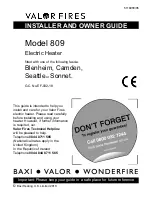
10
and glued into the end of the elbow that will mount on the
discharge adapter (see fig. 6).
6. An 1/8 inch bead of high temperature silicone should be
applied to the circumference of the discharge adapter just
before installing the first section of pipe or elbow.
INSTALLATION OF VENT SYSTEM, SIDEWALL
With the route of the venting system and selection of materials
completed, as discussed in section of this manual titled
PLANNING THE VENT SYSTEM, the through the wall vent
terminal in place and the first section of piping, up to first elbow,
installed at the blower it is time to complete the installation of
the venting system for the sidewall installation.
FIGURE 8
Before completing the installation of the venting system be sure
to read the sections of this manual discussing the proper method
of cutting and cementing PVC pipe and fittings: VENT PIPE
PREPARATION.
It is recommended that the completion of the venting system
start at the blower assembly and run to the coupling on the inside
wall of the vent terminal, Figure 5.
If condensate "TEE" is being installed to keep condensate from
running back to the blower, be sure to form trap in plastic drain
tube and run the condensate to a drain. See Figure 8.
The vent system piping should be supported every 5 feet of
vertical run and every 3 feet of horizontal run. All piping and fittings
must be joined by the proper procedures as described under:
VENT PIPE PREPARATION.
INSTALLATION OF VERTICAL VENT SYSTEM
This unit is approved for venting through the roof with only the
vent terminal that is included with the unit, see Figure 9. A proper
flashing or "BOOT" should be used to seal the pipe where it
exits the roof. The total vent system should not exceed the thirty
(30) equivalent feet of 3 inch pipe or sixty (60) equivalent feet of
4 inch pipe as listed in Table 1.
NOTE: The equivalent feet of pipe listed above are exclusive of
the "TEE" termination with installed screens.
Provide support for all pipe protruding through the roof. All piping
should be properly secured. The vent system piping should be
supported every 5 feet of vertical run and every 3 feet of horizontal
run. All piping and fittings must be joined by the proper
procedures as described under: VENT PIPE PREPARATION.
FIGURE 9
IMPORTANT
The vent system must terminate so that proper clearances are
maintained as cited in local codes or the latest edition of the
National Fuel Gas Code, ANSI Z223.1 and as listed below:
1. Vent Termination must extend a minimum of 12 inches above
roof or 12 inches above the anticipated snow level to prevent
blockage of the vent termination.
2. The venting system shall terminate at least four (4) feet from
or one (1) foot above any gable, dormer or other roof structure
with building interior access; i.e., vent, window, etc.
3. The venting system shall terminate three (3) feet above any
forced air inlet located within ten feet.
VENT PIPE PREPARATION
1. INITIAL PREPARATION
A. Make sure the solvent cement you are planning to use is
designed for the specific application you are attempting.
B .Know the physical and chemical characteristics and
limitations of the PVC and CPVC piping materials that you
are about to use.
C.
Know the reputation of your manufacturer and their
products.






































